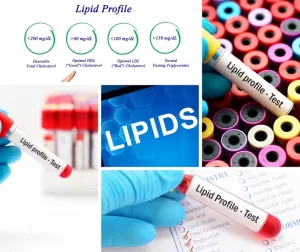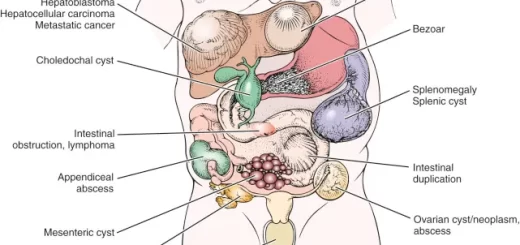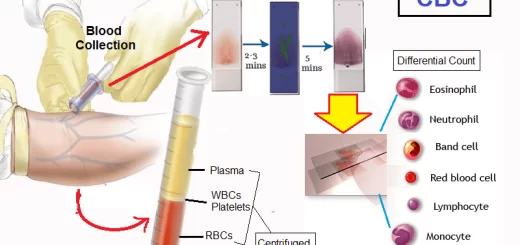Lipid profile test, Hyperlipidemia causes, Cholesterol sources and importance
The lipid profile is a panel of blood tests used to find abnormalities in lipids, such as cholesterol and triglycerides, The lipid profile blood test measures the total amount of cholesterol in your blood, the level of HDL-cholesterol, the level of LDL-cholesterol, and triglycerides.
Lipid profile
A $2 old man came to the outpatient clinic complaining of persistent fatigue and headache, On examination, his blood pressure was found to be 170/110 mmHg (average range: 120/80 mmHg), His hands and eyelid had yellowish depositions (xanthomas), When the patient was asked about his eating habits, he reported eating a lot of French fries from fast food restaurants, biscuits and burgers (TRANS-FAT).
He also reported suffering once from severe chest pain, but he just rested and did not seek medical consultation, The doctor asked the patient to go to the lab the following day after fasting 12 hours to check his blood lipid profile, The Fasting blood cholesterol level turned out to be 700 mg/dl (Normal < 200 mg/dl).
What is a lipid profile?
The lipid profile is a group of tests that are often ordered together to determine the risk of coronary heart disease, They are tests that are good indicators of whether someone is likely to have a heart attack, hypertension, or stroke caused by atherosclerosis.
Lipid profile typically includes:
- Total cholesterol (desirable level less than 200 mg/dL)
- High-density lipoprotein cholesterol (HDL-C)-often called good cholesterol (desirable fasting level of more than 60 mg/dL).
- Low-density lipoprotein cholesterol (LDL-C)-often called bad cholesterol (desirable fasting level less than 100 mg/dL).
- Triglycerides (desirable tasting level: Less than 150 mg/dl.)
An extended profile may also include:
- Very low-density lipoprotein cholesterol (VLDL-C).
- Friedewald equation is a method of calculation of LDL and VLDL concentration without colorimetry.
- LDL-cholesterol = (Total cholesterol] – [HDL-cholesterol] – ([T.G]/5)
- where all concentrations are given in mg/dl.
- VLDL = T.G/5
Sampling of blood for lipid profile
- Total lipid profile requires a 12-hour fast (no food or drink, except water).
- For the most accurate results, wait at least two months after a heart attack, surgery, infection, injury or pregnancy.
- Thyroid or liver disease and genetic conditions can affect the level of blood lipids.
- Drugs such as corticosteroids; estrogen or androgens; oral contraceptives: some diuretics; and antipsychotic medications, including haloperidol; some antibiotics and niacin can also affect the blood lipid level.
- If the blood sample is collected after a fatty meal, serum will appear turbid (lipemic), due high content of chylomicrons
- After a couple of hours of eating a fatty meal, plasma will be cleared by means of lipoprotein lipase (clearing factor).
Hyperlipidemia
Is the condition of abnormally elevated levels of any or all lipids and/or lipoproteins in the blood, It is considered a heterogeneous group of disorders.
Causes
- Primary hyperlipidemias are probably genetically based, but the genetic defects are known for only a minority of patients.
- Secondary hyperlipidemia may result from diseases such as diabetes, thyroid disease, renal disorders, liver disorders, and Cushing’s syndrome, as well as obesity, alcohol consumption, estrogen administration, and other drug-associated changes in lipid metabolism.
Hyperlipidemia is a major, modifiable risk factor for atherosclerosis and cardiovascular disease, including coronary heart disease; this is true for both of disorders involving hypercholesterolemia and hypertriglyceridemia.
Cholesterol
Chemistry:
Cholesterol is the most abundant sterol in human tissues and fluids, It has an eight-carbon-atom hydrocarbon chain that is numbered 20 to 27 as a continuation of the steroid nucleus, Some of the cholesterol present in humans is esterified, The hydroxyl group that projects from C3 is attached to a fatty acid residue in an ester linkage.
Sources:
Cholesterol is either obtained from the diet or synthesized completely from acetyl CoA human body.
- Sources in the diet: Food that is derived from animal products contains cholesterol e.g. eggs, meats, and dairy products such as butter, cheese, and cream, Some of the cholesterol contained in these animal products is in the form of cholesterol esters, Therefore, the ordinary diet contains a mixture of cholesterol and cholesterol esters.
- Sources in human body: Cholesterol in humans is synthesized by virtually all tissues, although the liver, intestine, adrenal cortex, and reproductive tissue including ovaries, testes, and placenta, make the largest contributions to the body’s cholesterol pool.
Biological importance:
Cholesterol performs a number of essential functions in the body:
- It is an essential component of plasma membrane and animal cells, it makes up a large proportion of the lipids of plasma membrane.
- It plays a major role in regulating membrane fluidity.
- Cholesterol is a precursor of bile salts. Its conversion to bile salts is the main catabolic pathway.
- Cholesterol serves as a substrate for some hormone synthesis. Although the amount of cholesterol converted into steroid hormones is small in terms of total cholesterol utilization, these reactions are of enormous importance in terms of body functions.
- Cholesterol is also a precursor of vitamin D3 (cholecalciferol).
Normal value: Normal cholesterol concentration in 12 hrs, fasting human 150-200 mg/dl, About 65% of the cholesterol in the plasma of normal fasting subjects is esterified.
Clinical Significance
Increased cholesterol levels above normal value (hypercholesterolaemia) will lead to its precipitation on the blood vessels causing atherosclerosis, This is often associated with an increased risk of ischaemic heart disease.
High cholesterol level is found in the following conditions
- Hypothyroidism.
- Diabetes mellitus.
- Nephrotic syndrome.
- Cholestasis.
- Xanthoma.
A sampling of Blood of Serum Cholesterol Investigation
Serum, or non-heparinized plasma, has to be separated from cells as soon as possible, Measuring blood cholesterol levels does not need fasting, Cholesterol level is not affected by a single meal but is affected by a long-term pattern of eating (change from a high-fat diet to a low-fat diet for several weeks).
Principle of Cholesterol estimation by colorimetry (By Enzymatic method)
This method includes enzymatic colorimeteric determination of cholesterol according to the following reactions:
Reagents
- Reagent 1: It is formed of pipes buffer of pH 6.9 and of a concentration of 50 mmol/L, Phenol of 24 mmol/L concentration, sodium cholate of 0.5 mmol/L.
- Reagent 2: It is formed of cholesterol esterase of not less than 200 U/L, cholesterol oxidase of not less than 250 U/L, peroxidase of not less than 1000 UL, and 4-aminoantipyrine of 0.5 mmol/L.
- Standard: Cholesterol of 200 mg/dl.
- Preparation of working reagent: Dissolve reagent 2 (powder) in 20 mL of reagent 1.
Procedure
- Prepare three test tubes labeled blank, standard, and sample.
- Mix well and allow to stand for 10 minutes at room temperature.
- Read the absorbance of the standard (A standard) and sample (A sample) against blank at 500 nm have length.
- Calculation:
Conc. Sample = (A sample/A standard) X Conc. standard = mg/dL
You can subscribe to Science Online on YouTube from this link: Science Online
You can download the Science Online application on Google Play from this link: Science Online Apps on Google Play
Blood analysis, Hemolysis, importance, structure, types, and hemolysis test results
Control of insulin secretion, diabetes mellitus, Glucagon, Somatostatin & features of DNES
Histology of pancreas, Structure of islets of Langerhans, Insulin function & Metabolism
Diabetes mellitus symptoms, causes, types, and sources of glucose in the blood
Bile pigments function, names, Cholesterol, Fatty acids, lecithin & Types of jaundice




